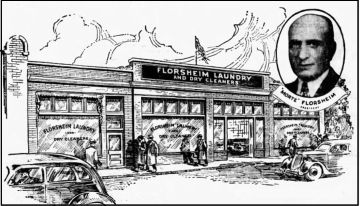|
The clippings above are all that I found in 1903–1904 newspapers
that put a trio of Richmond, Virginia siblings at the scene of a historic
fire in Chicago. At the Iroquois Theater on December 30, 1903 a backstage
fire during a matinee performance of Mr. Bluebeard quickly spread
to the auditorium and within fifteen minutes killed nearly six hundred people.
Over fifty years later in Morte Florsheim's obituary it was reported that
his sisters, Ruby Florsheim Flegenheimer and Miriam Florsheim, had initially
purchased seats in the gallery. After Morte teased them about the poor location,
the women exchanged their tickets for pricier seats. Since Miriam was ten
years old, the original ticket decision was likely led by big sister Ruby.
It was probably a life-saving ticket exchange. Seated in the last row of the center
section, the Florsheims, like hundreds of others on the first floor, were able to evacuate
the theater quickly. Had they been in the gallery there is a good possibility
they would not have survived. A majority of fatalities came from the balconies and
fewer than 1% were occupants of the ground floor. Morte was said to have helped
with the rescue effort after helping his sisters escape. Details of his activity
were not published, nor was it specified whether they fled through a fire escape
exit out into Couch Place alley or through the lobby and out onto Randolph St.▼1
|
|
|
Mordecai, Miriam and Ruby were the children of German immigrants, Benjamin Florsheim (1844–1897)
and Mollie Rothschild (1853–1931). The family owned a men's clothing store at the corner
of 4th and Broad streets in Richmond▼2 and lived in apartments on the floor
above. See advertisement for the store below. Of their six children there was only one son, Morte.
Twenty-five-year-old Mordecai B. Florsheim (1878–1961),▼3
nicknamed "Morte," and his wife, a girl from Charlotte, NC named Minnie Kaufman (1880–1939),
were newlyweds, having married the past January. It was not reported whether Minnie made the trip to
Chicago. If so, she was not mentioned as having been in the theater party with her husband and sisters-in-law.
The birth of their first child, Rae Bertha Florsheim (1904–1979) was a year off.
(Another daughter followed: Margaret B. Florsheim (1908–1994).)
After a long and busy life (see clippings below,
including one that suggests Morte worked a bit too hard, according to local morality
police), Morte died of hemorrhaging following surgery on a peptic ulcer.
In Richmond he founded five laundry companies — the Jefferson, Royal, Manhattan, Florsheim
and Moizelle's — as well as the the Virginia Carolina Laundry Supply Co., and in Miami, Florida
the Gray-lyn Laundry. His interests in Richmond extended beyond laundries; he built the
Hotel Sevilla
Apartments, Jefferson Market and owned a portion of the Richmond Paper Company.
According to his 1898 passport Mordecai was 5' 5" tall with brown eyes and dark brown hair.

|
 |
Nineteen-year-old Ruby Florsheim Flegenheimer (1884–1943) had been married only
three months when she escaped from the Iroquois Theater. The marriage to Isaac Flegenheimer,
a Prudential banker, did not last and in 1923 she remarried Samuel Mendelson. Together
they operated a hat manufacturing company. At the time of her death she was living in
Portland, Oregon.
Ruby was the sister who things happened to. In 1900 she had malaria.
In 1908 during a baseball game at Cubs Park in Chicago she was hit in the head by a ball that
went into the grandstand. She was not knocked unconscious, in fact retrieved the ball as
evidence for her subsequent $10,000 lawsuit. Story disappeared from newspapers.
Ten-year-old Miriam Zenobia Florsheim (1893–1965)▼4 would in 1916 marry Harold
Mark Salomon, one of her brother's fellow laundry owners, and spent most of her
adulthood in Chicago. They had a daughter named Virginia Lee Solamon, possibly after a sister,
Virginia "Maud" Florsheim, who died at age twelve. Her death had come six months before
Miriam's birth and the family's grief may have impacted Miriam's early childhood.
|
|
Discrepancies and addendum
1. I smiled while reading fanciful 1957 and 1961 news stories about Morte having
turned in the alarm at the fire. I worked on an Iroquois story last week
about another survivor who was claimed to have turned in the first alarm. I've found
several such stories in newspapers outside Chicago. Sometimes the "first alarm" story
emerged because the newspaper wasn't motivated to distinguish between the subject having
alerted companions in his own theater party, i.e., "Ruby, the curtain is on fire!"
versus running to an alarm box on the street. Hometown heroes sold newspapers and finding
a witness in their own back yard tempted editors to embroider. The 1957 story, much
of which was repeated four years later in Mordecai's obituary, was shy on details and
contained substantive errors about the fire, such as that it was started by an exploding
acetylene tank. That said, the newspaper may have
reported what it was told by Morte. His advertisements for his laundry featured
superlatives and I suspect he might have been a bit of a character, a man who enjoyed
telling an entertaining story.
2. Today home to ML Steak's downtown restaurant, located in Richmond's historic art district. Seems the
location was formerly Fatty Smokes, a BBQ restaurant that didn't survive the Covid pandemic.
3. In the newspaper notice about Mordecai's presence at the
Iroquois Theater his name was spelled Florshein but Florsheim ending in an m was the
spelling the family commonly used. I've also found the spelling Florscheim but
Mordecai used Florsheim on his WWII draft card and passport.
Both Mordecai and Mordechai are acceptable
spellings of the Jewish hero after which Mordecai was probably named. The h version was
not used on his grave marker or death certificate.
4. Miriam's name was later sometimes given as Marian.
|
